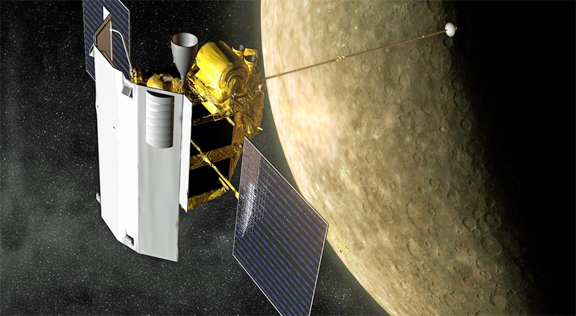[SatNews] When the sun hurls a billion tons of high-energy particles and magnetic fields into space at speeds of more than a million miles per hour and the "space weather" conditions are right, the resulting geomagnetic storm at Earth can wreak havoc on communication and navigation systems, electrical power grids, and pose radiation hazards to astronauts and airline passengers and crew.

Artistic rendition of NASA's MESSENGER spacecraft orbiting Mercury.
Image is courtesy of NASA/Johns Hopkins University Applied Physics Laboratory/Carnegie Institution of Washington.
Being able to predict when those conditions are right is a key scientific goal, and researchers from the University of New Hampshire's Space Science Center (SSC) are now adding some powerful tools to the predictive toolbox using data from NASA's MErcury Surface, Space ENvironment, Geo-chemistry, and Ranging, or MESSENGER, spacecraft, which orbited our solar system's innermost planet, Mercury, beginning in March 2011 until its planned crash into the planet on April 30, 2015.
In a paper published in the Journal of Geophysical Research-Space Physics, SSC postdoctoral researcher Reka Winslow and colleagues use observations from MESSENGER to investigate the sun's powerful interstellar coronal mass ejections (ICMEs) close to the source in an effort to track and analyze the evolution of these solar storms and improve the forecasting of their arrival times at Earth.
"MESSENGER was the first spacecraft since the 1980s to make measurements of the interplanetary medium close to the sun," said Winslow, "and the resulting data presents a unique opportunity for studying the evolution of ICMEs as they expand and propagate outward well before they reach Earth."
The research is unique because MESSENGER was a planetary mission focused on understanding Mercury itself, but MESSENGER's onboard magnetometer also collected a wealth of data relative to ICME magnetic fields, which is what the UNH researchers are using in hopes of improving space weather prediction.
"MESSENGER's observations have not been mined for ICME-related data so it's very exciting for the scientific community that this data exists and is now publically available," Winslow said. Among other things, the scientific community can plug the data into models and simulations to help verify the robustness and accuracy of current predictive capabilities. The data will also help scientists prepare for NASA missions to the inner solar system coming up in the next five years such as the Solar Probe Plus and Solar Orbiter spacecraft, both of which involve UNH space scientists. These upcoming missions will explore some of the same regions as MESSENGER so it will be invaluable to compare the datasets and observations."
A key, initial finding from the MESSENGER magnetometer data concerns the speed and deceleration of ICMEs after their launch from the sun. Currently, scientists don't know exactly where on average ICMEs stop slowing down and continue towards Earth at a constant speed—a critical missing piece of the predictive puzzle.
"From MESSENGER's data we know the deceleration phase continues beyond Mercury's orbit and stops before it gets to Earth, but where it reaches that point of constant speed is unclear," Winslow said. "And if we want to be able to forecast ICME arrival times at Earth more accurately we need to have a better handle on the deceleration of ICMEs beyond Mercury's orbit."
Moreover, because the orientation of an ICME's magnetic field is crucial to the potential strength of an ensuing geomagnetic storm, the UNH scientists are also using the MESSENGER data to help determine how these magnetic fields might evolve and change direction during their passage to Earth. In short, if an ICME magnetic field at Mercury is oriented in a way that wouldn't pose a threat at Earth, if it can be determined that the orientation stays the same during its 48-million-mile journey, the space weather forecast at Earth can be "all clear."
Winslow said, "You want that forecasting power so you can say, 'Even though we know this ICME will hit the Earth, its magnetic field direction is aligned in such a way that it's not going to cause a geomagnetic storm.' That's something we're testing right now with the observations from MESSENGER."
Story by Science Daily and the University of New Hampshire.


